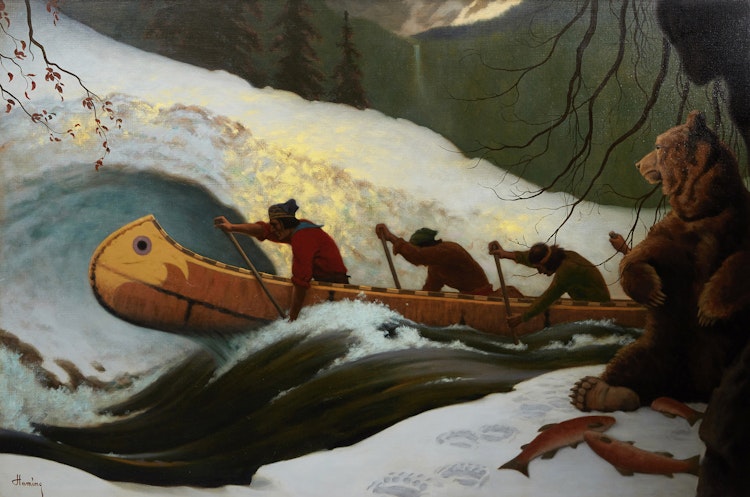A Rocky Mountain Packet by Arthur Henry Howard Heming

Arthur Heming
A Rocky Mountain Packet
oil on canvas
signed lower left; signed and titled on the stretcher
32 x 48 ins ( 81.3 x 121.9 cms )
Auction Estimate: $10,000.00 - $15,000.00
Price Realized $36,000.00
Sale date: November 22nd 2021
Collection of General Motors, Oshawa, Ontario
Private Collection, Ontario
Editorial Department, “The Toronto Star”, Arthur Heming Fonds, National Gallery of Canada Archives, undated, unpaginated
William G. Colgate, “Arthur Heming, Recorder of the North”, Fine Art Gallery, Eaton’s, 1933, unpaginated
According to a letter dated 1955 from Mr. W.E. Austin, Public Relations Manager of General Motors (GM), to Mr. T.E. Lee, three paintings by Heming were hanging in the offices of the
Senior Executives of GM. “A Royal Mountain Packet” was one of these paintings, acquired for a calendar series that GM designed to exhibit different methods of transportation. Depicted with vivid colour, sublime light, and exaggerated drama, “A Royal Mountain Packet” illustrates the idea of a traditional passenger boat carrying mail or cargo - in this instance a canoe - slicing through rushing water. Close by, a large bear is feasting on its catch.
Heming does not belong to a particular school, movement or group in the sphere of Canadian art history. According to William Colgate, Heming was very much an individualist: “Heming paints with a broad elimination of superfluous details, preserving in his design a quiet simplicity, and presenting a vivid, moving panorama of essential truths.”
Share this item with your friends
Arthur Henry Howard Heming
(1870 - 1940)
Born in Paris, Ontario, Heming moved with family to Hamilton, Ontario when he was 12. Heming had dreams of becoming an artist and traveller, a dream which led to his study in the evenings at the Hamilton Art School. There at age of 16 he was appointed assistant to the Master where he continued to teach for 16 years (1887-1890). His search for physical challenge led him into the field of sports where he excelled. Heming played lacrosse, football and was a champion at cross-country running.
He started his trips to the wilderness at the age of 16. About 1890 he became a free lance illustrator and submitted many ‘chalk drawings’ to the Hamilton Spectator. Later he made a snowshoe trip to the Temiskaming area where he got material for a series of illustrations on Iroquois Indians for Harper’s Weekly. By 1899 Heming was in New York City where he studied at the Art Student’s League under Frank Vincent Dumond. By 1904 Heming was in London, England, where he studied under Frank Brangwyn who was a noted muralist and etcher. While attending one of his art classes in Canada or the United States, Heming was told that he was partially colour blind. Fearing he would make wrong colour judgments he worked in black, white and yellow until he was sixty years old. It was then that he learned through his artist friend Richard Jack, R.A., that he was no longer colour blind.
His illustrations adorned the pages of many publications of the world and he was hailed for this internationally. His first book “Spirit Lake” was published in 1907. The book deals with the era of the Hudson Bay Company when the wilderness was the free realm of the Indian, and the Indian’s life is very much revealed in the book. By 1910 Heming was back in Toronto, though he moved and travelled frequently in Canada and the U.S. He was one of the first artists to occupy the Studio Building in Toronto built by Lawren S. Harris and Dr. James MacCallum in 1914. Heming held a solo show in Toronto in 1920 and the following year ten of his paintings were purchased by the Royal Ontario Museum.
Heming’s last book “The Living Forest” was published in 1925 when it also appeared in serial form in ‘Mclean’s Magazine’. W. J. Phillips in his article on Heming explained how he moved into colour, “Heming painted pictures in colour for exactly ten years. Prior to that he worked in black and white and yellow. ‘The Living Forest’ is illustrated with pictures done in this technique. Very charming they are, with the decorative quality of a Japanese print. His first picture in colour was ’To Dance the New Year In’. During the course of his career Heming’s were reproduced in international illustrated periodicals including ‘Illustrated London News’, ‘Le Monde Illustré’, ‘New York Times Magazine’ and ‘Berliner Illustrate Zeitung’. A solo show of his paintings was held in London, England at the gallery of Messrs. Frost & Reed, Ltd. The exhibition was a triumph as were his magazine illustrations.
Heming was elected an Associate of the Royal Canadian Academy in 1934. He gave up painting in 1940 because of a sudden failure of the muscles of his hands. Nine months after he stopped painting he passed away in Hamilton, Ontario. He had been working on his fourth book.
Source: "A Dictionary of Canadian Artists, Volume II”, compiled by Colin S. MacDonald, Canadian Paperbacks Publishing Ltd, Ottawa, 1979

